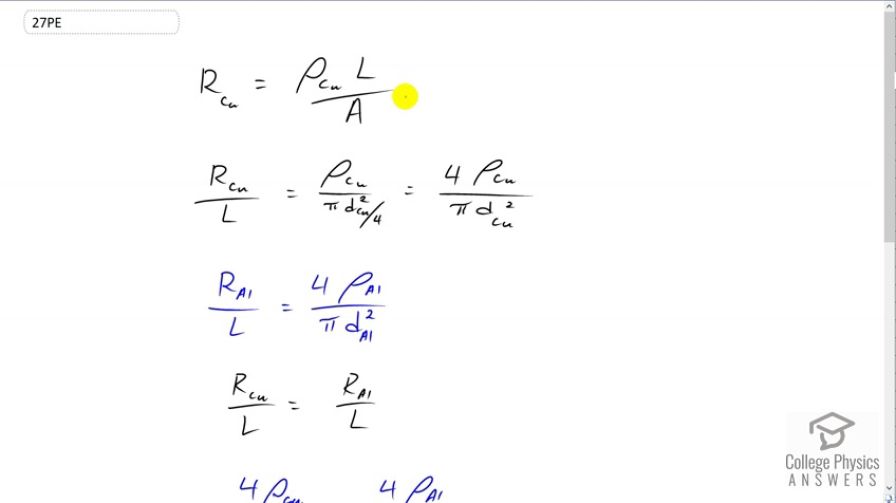Question
Find the ratio of the diameter of aluminum to copper wire, if they have the same resistance per unit length (as they might in household wiring).
Final Answer
Solution video
OpenStax College Physics, Chapter 20, Problem 27 (Problems & Exercises)

vote with a rating of
votes with an average rating of
.
Calculator Screenshots
Video Transcript
This is College Physics Answers with Shaun Dychko. We're told that some copper wire and some aluminum wire have the same resistance per length. So what is the ratio of their diameters because since they have different resistivities, they're going to require different diameters in order to have the same resistance per length. The aluminum is going to have to be bigger. So resistance of the copper wire is the resistivity of copper multiplied by its length divided by its cross-sectional area. But we want the resistivity per length. So we multiply this by one over l on both sides. So we have -- that's an l there. So we have resistance of copper per length equals resistivity of copper divided by the cross-sectional area and I've substituted pi d squared over four in place of A. This is d subscript Cu to say that this is the diameter of the copper wire. Then multiply top and bottom by four since it's kind of messy looking to have a fraction within a fraction. So we have four rho Cu over pi d Cu squared. Then for aluminum it's the same idea, we're just substituting Al subscript everywhere. We're told that resistivity of the copper per length equals -- I should say the resistance, not the resistivity. So the resistance of copper per length equals the resistance of the aluminum per length and so we can equate this with this. That's what we've done here. So a few things cancel here and we'll do it all in one step here. We're going to get the ratio of the diameter of the aluminum wire to the diameter of the copper wire squared, by multiplying top and bottom by -- oh sorry, left and right I should say -- by diameter of aluminum squared and then well, also multiply by pi. Then divide both sides by four and that'll get rid of the four and the pi and that'll since we're multiplying both sides by this fraction here. That'll get rid of the diameter of the aluminum squared on the right and will also throw in the rho Cu on the bottom there so that that cancels with that, leaving us with diameter of aluminum squared on top there and then the resistivity of copper will appear in the denominator on the right hand side. Okay. So, then take the square root of both sides and we have the ratio of the diameters of the wires is the square root of the ratio of the resistivities of the materials. So we have square root of resistivity of aluminum, 2.65 times ten to the minus eight ohm meters, divided by resistivity of copper 1.72 times ten to the minus eight ohm meters. That means that the diameter of the aluminum will have to be 1.24 times that of the copper.
